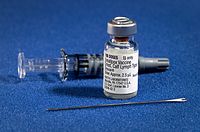
Photo from wikipedia
We describe a new assaying system for the detection and genotyping of human papillomavirus (HPV) based on linear-after-the-exponential-PCR(LATE-PCR) and melting curve analysis. The 23 most prevalent HPV strains (types 6,… Click to show full abstract
We describe a new assaying system for the detection and genotyping of human papillomavirus (HPV) based on linear-after-the-exponential-PCR(LATE-PCR) and melting curve analysis. The 23 most prevalent HPV strains (types 6, 11, 16, 18, 31, 33, 35, 39, 42, 45, 51, 52, 53, 56, 58, 59, 66, 68, 70, 73, 81, 82, and 83) are assayed in two sealed reaction tubes within 2 h. Good sensitivity and specificity was evaluated by testing cloned HPV DNA and clinical samples. The detection limit was 5–500 copies/reaction depending on the genotype. No cross-reactivity was observed with the other HPV types that are not covered by our method or pathogens tested which were commonly found in female genital tract. When compared with the HPV GenoArray Diagnostic kit, the results from 1104 clinical samples suggest good overall agreement between the two methods,(98.37%, 95% CI: 97.44%–98.97%) and the kappa value was 0.954. Overall, this new HPV genotyping assay system presents a simple, rapid, universally applicable, sensitive, and highly specific detection methodology that should be useful for HPV detection and genotyping, therefore, is potentially of great value in clinical application.
Journal Title: PLoS ONE
Year Published: 2018
Link to full text (if available)
Share on Social Media: Sign Up to like & get
recommendations!